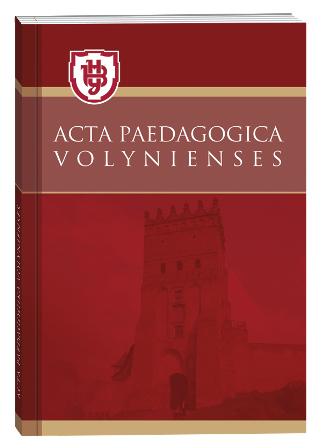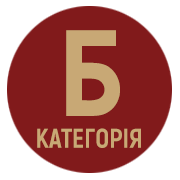THE ROLE OF THE TANDEM LANGUAGE LEARNING METHOD IN FORMING MULTILINGUALISM OF GENERAL SECONDARY EDUCATION STUDENTS
DOI:
https://doi.org/10.32782/apv/2023.1.8Keywords:
the tandem language learning method, tandem training, tandem partners, multilingual education, multilingual competence, cross-cultural communication, lifelong learningAbstract
The article considers the issue of introducing the tandem language learning method with regard of improvement of the language sector of Ukrainian education, its role in the implementation of the model of multilingual education in Ukrainian institutions of general secondary education with instruction in languages of indigenous peoples and national minorities. It is noted that the introduction of innovative methods in the process of integrated language teaching, namely, the tandem language learning method, is a topical issue. The article analyzes the tandem language learning method in comparison with traditional methods of language teaching and the status pitting it into practice by Ukrainian language teachers. The basic views on the use of the tandem language learning method in research works by foreign and Ukrainian scientists are presented. The fundamental principles of the tandem language learning method are considered: reciprocity and autonomy; the pedagogical context for its implementation is defined; the main stages of communication in tandem are described; the requirements for tandem partners in the process of preparing and implementing communication are formulated. The results of introduction the tandem language learning method in experimental schools and issues that need to be tackled while its implementation, are presented. The positive impact of using the tandem language learning method on the efficiency of forming multilingualism of general secondary education students is substantiated. It was determined that the tandem method in combination with information and communication technologies helps to actualize a multilingual, multicultural virtual environment as a result of expanding language contacts of male and female students. The tandem method is optimal for practicing students’ communication skills in the process of real communication. Its use helps to overcome language and psychological barriers in communication with tandem partners due to the lack of strict control by the teacher and a number of techniques aimed at supporting effective communication between them (clarifications, questioning, formulating an idea in other words, using gestures, means of non-verbal communication , replacing complex constructions with simple ones, etc.), development of the ability to intercultural communication based on the principles of equality and tolerance.
References
Apfelbaum.B. Erzählenim Tandem: Sprachlernaktivitätenund die Konstruktioneines Diskursmustersin der Fremdsprache; (Zielsprachen:Französisch und Deutsch). Tübingen: Narr, 1993. 235 S.
Bausch, K.-R. Ansprachezum Auftakt des EuropäischenJahres derSprachen, 2001.11 Shttps://westfaelische-direktorenvereinigung.de/wordpress/wp-content/uploads/2001/11/Referat-Bausch.pdf (дата звернення 15.09.22)
Bechtel, M. Interkulturelles Lernenbeim Sprachenlernenim Tandem. Einediskursanalytische Untersuchung. Tübingen: Gunter Narr, 2003. 387 S.
Born, J. Das eLearning-Praxisbuch: оnlineunterstützte Lernangebote in Aus– und Fortbildungkonzipierenund begleiten;еin Hand– und Arbeitsbuch. Baltmannsweiler: Schneider Verlag Hohengehren GmbH, 2008. 251 S.
Brammerts, H., Kleppin K. Selbstgesteuertes Sprachenlernenim Tandem:einHandbuch. 3. Aufl., unveränd. Nachdr. der 1. Aufl.Tübingen:Stauffenburg-Verlag, 2010. 206 S.
Little, D., Lewis, T., Walker, L. Autonomous language learning in tandem. Sheffield: Academicand Electronic Press, 2003. P. 145–156.
Telles J. A., Vassallo M. L. Foreign language learning in-tandem: Teletandem as an alternative proposal in CALLT.2006. Vol. 27, No 2, P. 189–212.
Thomas, A., Kinast, E.-U.,Schroll-Machl S. (Hrsg.).HandbuchInterkulturelle Kommunikation und Kooperation. Band 1: Grundlagen undPraxisfelder.Göttingen:Vandenhoeck&Ruprecht, 2003. 465 S.
Holec, H. Prise en compte des besoinsetapprentissage auto-dirigé. Mélanges Pédagogiques 1979. Р. 49–64.
Holec, H. Autonomy and self-directed learning: present fields ofapplication = Autonomie et apprentissageautodirigé: terrains d’applicationactuels/ Council for Cultural co-operation, Project. No. 12 .«Learning andteaching modern languages for communication». Strasbourg: Councilof Europe Press, 1993. 149 S.
Holstein S. Sprachen-Tandem fürPaare, Kurse, Schulklassen: einLeitfadenfürKursleiter, Lehrpersonen, Migrantenbetreuer und autonomeTandem-Partner. Frankfurt am Main: Fachhochschulverl, 2006. 174 S.
Бігич О. Б. та ін Методика навчання іноземних мов і культур: теорія і практика / за ред. С. Ю. Ніколаєвої. Київ: Ленвіт, 2013. 590 с.
Жукевич, І. Технології навчання іноземній мові в тандемі студентів немовних закладів вищої освіти. Актуальнi питання гуманiтарних наук. Випуск 2(27) Дрогобич:Державний педагогічний університет імені І.Франка, 2020. С. 226–230.
Забіяка, І. М. Модель формування міжкультурної компетенції майбутніх фахівців технічного профілю на основі тандем-методу. Наукові записки Національного університету «Острозька академія»: серія «Філологія». Острог: Вид-воНаУОА, 2022. Вип. 13(81). С. 131–135.
Кравчина Т.В. Тандем-метод як один із способів інтенсивного вивчення іноземної мови та формування іншомовної комунікативної компетенції. Фізико-математична освіта: науковий журнал. 2016. Випуск 4(10). С. 45–48.
Ніколаєва, С. Ю. Основи сучасної методики викладання іноземних мов (схеми і таблиці): навч. посіб. Київ: Ленвіт, 2008. 285 с.
Осова О. О. Тандем-технології як сучасні технології навчання іноземних мов. Педагогічні науки. 2017. No 5. С. 87–91.
Сисоєва С.О. Інтерактивні технології навчання дорослих: навчально-методичний посібник. НАПН України, Ін-т педагогічної освіти і освіти дорослих. К.: ВД «ЕКМО», 2011. 324 с.







